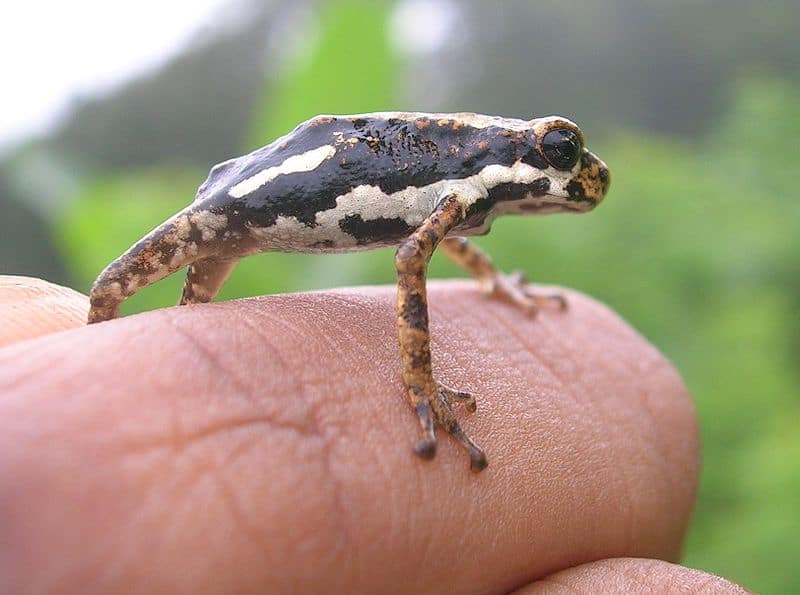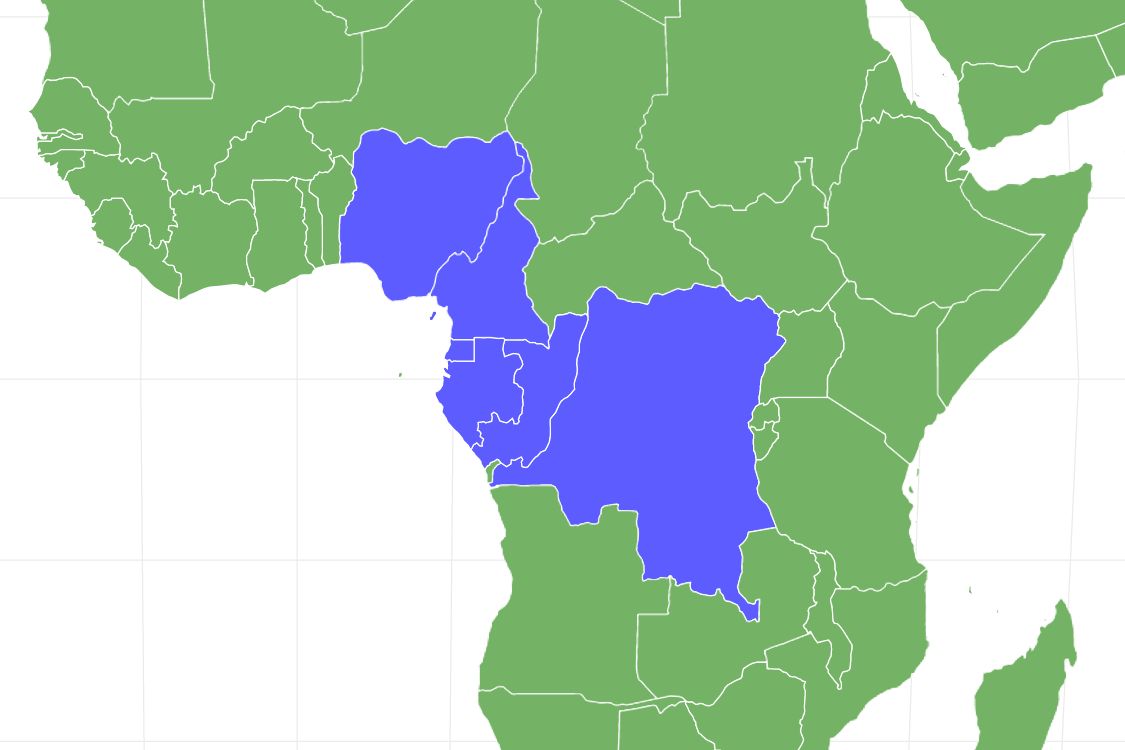Found in tropical moist lowland forests!
Advertisement
African Tree Toad Scientific Classification
- Kingdom
- Animalia
- Phylum
- Chordata
- Class
- Amphibia
- Order
- Anura
- Family
- Bufonidae
- Genus
- Nectophryne
- Scientific Name
- Nectophryne afra
Read our Complete Guide to Classification of Animals.
African Tree Toad Conservation Status
African Tree Toad Facts
- Prey
- Insects, Worms, Snails
- Distinctive Feature
- Small body size and webbed feet
- Average Spawn Size
- 100
- Habitat
- Tropical lowland forest
- Predators
- Fish, Toads, Birds
View all of the African Tree Toad images!
Like many other toads and frogs in the same family, the African Tree Toad’s toxins have medicinal uses.

The African tree toad is a small toad in the family Bufonidae, in the order Anura. Its habitat is the tropical and subtropical lowland forests of West and Central Africa. Its color is a combination of brown, black, white, and tan. Although it is not a vulnerable species, it can suffer from local habitat loss.
4 Incredible Facts!
- The African Tree Toad is a true toad, which means it is a tailless amphibian similar to a frog but more terrestrial and having drier warty skin.
- It has long, thin, webbed feet for its semi-aquatic, tree-dwelling lifestyle.
- It can shoot its long sticky tongue out to catch prey at lightning speed.
- It can reach a top speed of 5mph.
Scientific Name
The scientific name of the African tree toad is Nectophryne afra. There are only two species in the Nectophryne genus: the African tree toad and the Bates’s tree toad (Nectophryne batesii).
This genus is part of the Bufonidae family in which all the members are true toads. There are 35 genera in the family Bufonidae.
It is the only family in the order Anura in which all members are toads, although some may be called frogs (e.g., the harlequin frog). Otherwise, the order Anura, an order of short-bodied tailless amphibians, has a mix of frogs and toads.
Appearance

The small (one inch long) African tree toad has camouflage coloring for hiding in the trees.
©Bernard DUPONT / CC BY-SA 2.0, Flickr – License
These toads has a camouflaging array of colors: Brown, black, white, and tan. Its small body is generally dark to light brown, with patches of white on its belly. This combination allows it to hide from predators in the grass as well as in trees. It also has long legs with long-thin webbed toes with round discs at the ends to enable it to climb and hop, while the partial webbing and wide toe separation enables it to get a strong grip on wide surface areas. Size-wise it grows anywhere from 2.5cm – 3.8cm (1 inch-1.5 inches) in length and 2g – 5g (0.07oz – 0.18ozs) in weight. Classification of the two subspecies is based on geographic location; otherwise, they are of similar color and size.
Behavior
These toads are terrestrial (land-dwelling) and semi-aquatic by day, finding food and water on the ground and spending most of their time in water outside of the breeding season. Their tiny size and camouflage make them difficult to spot on the forest floor. They use their partially webbed feet to hop and climb. At night, they use their camouflage and climbing ability to hide up high in the trees away from predators. They have solitary lifestyles.
Habitat

African tree toads have an amphibious, semi-aquatic lifestyles, but their habitats are threatened by deforestation and pollution.
©L. Shyamal Shyamal, CC BY-SA 3.0, via Wikimedia Commons – License
Both kinds of African tree toads have an amphibious, semi-aquatic lifestyle, so they prefer to live in the moist and tropical or subtropical climate of lowland forests or heavily degraded former forests with small bodies of freshwater. All members of the genus Nectophryne are native to Nigeria, Cameroon, Gabon, northeastern Congo, Bioko, and Equatorial Guinea.
The habitat range of the African tree toad is West and Central Africa, extending from southwestern Nigeria through Cameroon to Equatorial Guinea (including Bioko), Gabon, and the northeastern Democratic Republic of the Congo.
The Bates’s tree toad is found anywhere from southern Cameroon to southwestern Gabon through the southwestern Central African Republic to the northeastern Democratic Republic of the Congo.
Both species suffer from habitat loss due to deforestation and pollution of air and water, currently restricting them to tall forests.
Diet
The diet of these toads is carnivorous. It shoots out its long sticky tongue at lightning-fast speeds to catch its prey. Plus, it can move at a top speed of 5mph (8km).
Like other toads, African tree toads are predators. They lie quietly in wait to catch their prey. They then use their tongues to catch spiders, worms, snails, and other small invertebrates and insects.
Predators and Threats

The African Tree Toad is sought after for its secretions, and bone and muscle tissue that are used in medicines.
©L. Shyamal Shyamal, CC BY-SA 3.0, via Wikimedia Commons – License
These toads are preyed upon by birds, fish, snakes, lizards, rodents, and larger toads and frogs.
Besides natural predators, these toads are sought after by humans for the exotic pet trade and for the toxins secreted by their permeable skin and parotid glands that, along with bone and muscle tissue, have medicinal uses. Therapeutic compounds from 15 of the 47 frog and toad species used in traditional medicine are from the family Bufonidae, serving as a variety of remedies ranging from infections, bites, allergies, and inflammation to pain, heart disorders, cancer, and AIDS. Preservation of the species means the preservation of their toxins as medicine.
Although it is listed as Least Concern in terms of conservation status by the IUCN, it suffers from habitat loss and may compete with other toad species for food. Currently, it is restricted to living in taller forests.
Reproduction, Babies, and Lifespan
These toads breed during the spring, either in tree cavities containing water or plant-filled water hollows. The female lays an average of 100 eggs, but possibly up to 200 eggs, after which the male guards the spawning site until the eggs hatch into tadpoles, which takes 6-21 days. After the tadpoles develop into young toads, they leave the nest to hunt on their own. Their lifespan is 3-5 years in captivity, while their lifespan in the wild is unknown.
Population
These toads are known to have a wide habitat range with groups of small populations throughout. While their exact numbers are unknown and they suffer from habitat loss, they are listed as Least Concern by the IUCN.
In the Zoo
These toads are present in a number of national parks, including the Korup National Park, which is on the border of Cameroon and Nigeria; Monte Alén National Park, which is near the center of Equatorial Guinea in central Africa; and Virunga National Park, which is in the eastern part of the Democratic Republic of the Congo. The national parks exist as reserved areas to provide natural biodiversity for several flora and fauna species, unlike zoos, which keep animals in special enclosures with artificial habitats. Korup National Park, for example, has never been logged, and so serves as a protected habitat for the African tree toad.
View all 194 animals that start with AAfrican Tree Toad FAQs (Frequently Asked Questions)
Are African Tree Toads herbivores, carnivores, or omnivores?
African Tree Toads are Carnivores, meaning they eat other animals.
What Kingdom do African Tree Toads belong to?
African Tree Toads belong to the Kingdom Animalia.
What phylum do African Tree Toads belong to?
African Tree Toads belong to the phylum Chordata.
What family do African Tree Toads belong to?
African Tree Toads belong to the family Bufonidae.
What order do African Tree Toads belong to?
African Tree Toads belong to the order Anura.
What type of covering do African Tree Toads have?
African Tree Toads are covered in Permeable skin.
What genus do African Tree Toads belong to?
African Tree Toads belong to the genus Nectophryne.
Where do African Tree Toads live?
African Tree Toads live in central Africa.
In what type of habitat do African Tree Toads live?
African Tree Toads live in tropical lowland forests.
What are some predators of African Tree Toads?
Predators of African Tree Toads include fish, toads, and birds.
What does the African tree toad sound like?
Tree toads tend to have shrill, high-pitched sounds and mostly call during the breeding season. They develop their own unique sound among different species. However, not much is known about the African tree toad as it is difficult to find and observe.
What part of the world does the African tree toad live in?
A wide range in Central and Western Africa with small population patches through Cameroon, the Democratic Republic of the Congo, Equitorial Guinea, Gabon, Nigeria and possibly Central African Republic and Republic of the Congo.
How does the African tree toad get its food?
It catches live prey with its long, sticky, and lightning-fast tongue after lying quietly in wait.
How big is the African tree toad?
It is tiny, ranging from 2.5cm – 3.8cm (1in – 1.5in) in length and 2g – 5g (0.07oz – 0.18oz) in weight.
What does the African tree toad look like?
A tiny toad with long, partially-webbed feet. Its widespread, long toes have round discs on the end. Its body has dark to light brown colors with white patches on its belly.
What is the difference between African tree toads and African tree frogs?
Both tree toads and tree frogs tend to be small in order to be able to climb and hide well in trees. However, all toads are frogs but not all frogs are toads, with toads having unique features that distinguish them from the main frog group. Both are amphibians belonging to the order Anura, with true frogs belonging to the family Ranidae and true toads belonging to the family Bufonidae.
What are some distinguishing features of African Tree Toads?
African Tree Toads have small bodies and webbed feet.
What is an interesting fact about African Tree Toads?
African Tree Toads are found in tropical moist lowland forests!
What is the scientific name for the African Tree Toad?
The scientific name for the African Tree Toad is Nectophryne afra.
What is the lifespan of an African Tree Toad?
African Tree Toads can live for 3 to 5 years.
How fast is an African Tree Toad?
An African Tree Toad can travel at speeds of up to 5 miles per hour.
How do African Tree Toads have babies?
African Tree Toads lay eggs.
How to say African Tree Toad in ...
Thank you for reading! Have some feedback for us? Contact the AZ Animals editorial team.
Sources
- Wikipedia, Available here: https://en.wikipedia.org/wiki/African_tree_toad
- Animals Adda, Available here: https://animalsadda.com/african-tree-toad/
- Kids Konnect, Available here: https://kidskonnect.com/animals/african-tree-toad/
- Smithsonian Tropical Research Institute, Available here: https://stri.si.edu/story/frog-toxins-medicine
- Reptile Guide, Available here: https://reptile.guide/frogs-vs-toads/
- Diffen, Available here: https://www.diffen.com/difference/Frog_vs_Toad

















